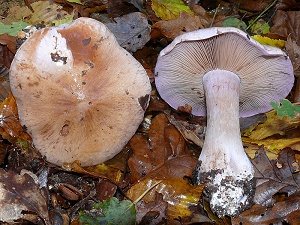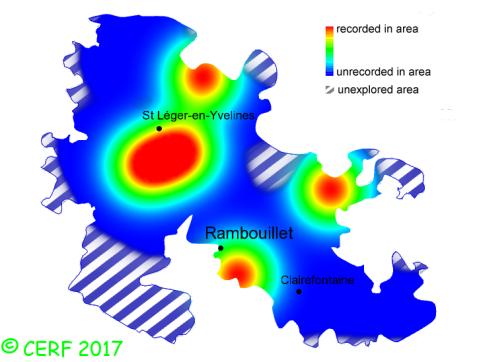| Cortinarius largus Fr. |
|
|
|
|
|
|
The cap is pale lilac to blue-grey, then progressively ochre-brown from the centre, convex then expanded; its margin is smooth, incurved for a long time. The cap surface is smooth, viscid, but slightly, becoming silky when dry. The stem is full, slightly bulbous but with a bulb without ridge, somtimes cylindrical or simply swollen at the base, with a white mycelial down at the base. It is violaceous at first, then only remaining so at the top, becoming more pallid or whitish downwards, with a quite abundant cortina, thin, pale brown. The flesh is pale lilac-white, turning white in the stem and centre of cap when exposed to air; its taste is mild, tasteless or sweetish; the odour is indistinct to faint, fruity or of iodine; its texture is fibrous. The gills are pale lilac-blue at first then clay-ochraceous to rust, emarginate to shortly adnate, with a toothed edge, crowded . The spore print is rusty brown. This species is mycorrhizal. It grows on the ground, in deciduous woods, on a rather calcareous soil, most of the time with beech and oak. The fruiting period takes place from July to November.
Chemical tests : flesh turning very pale yellow when in contact with potash, or without any reaction. Distinctive features : pale lilac cap, later becoming ochraceous brown starting from the centre, only slightly viscid; stem with violaceous apex, whitish towards base; lilac gills later becoming ochre to rusty brown; lilac flesh, turning white in stem when exposed to air, with a fruity odour; with beech and oak, on calcareous soils Cortinarius largus is quite rare and localised in the forest of Rambouillet, and is infrequent, more generally speaking . | ||
|
page updated on 14/01/18

